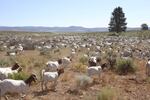Drive down Highway 395 between John Day and Burns, and it’s impossible to miss Silvies Valley Ranch.
The sprawling property seems to go on for miles and miles in this remote stretch of eastern Oregon, where cell signals are rare and cows outnumber humans by about 10 to 1. Most Grant County ranch entrances include a simple wooden sign, with maybe a bleached cow skull hanging from a lodgepole arch. Silvies Valley Ranch properties are marked with uniform metal and wood signs that bear the ranch’s abstract logo, visible from about a mile away.
“I think a lot of people driving through go, ‘What the heck is this?'” said Judge Scott Myers, Grant County’s top elected official. “It is a step aside for us.”

Silvies Valley Ranch owner Scott Campbell on one of three golf courses at the ranch. Campbell says it's the second reversible course in the world and includes many "green" features.
Amanda Peacher / OPB
In 2006, a wealthy veterinarian from Burns bought this property with a vision: Scott Campbell would transform what was then a dilapidated dude ranch into an elite destination resort for foreigners. He would optimize ranching practices to create a thriving organic cattle and goat operation.
Campbell believes if he’s successful, he’ll prove that high-end tourism is a new way forward for rural Oregon, where communities often struggle with high unemployment and poverty rates. He hopes others will follow his model and open similar resorts across Oregon’s high desert.
But some fear that the Silvies Valley Ranch development could bring unwelcome change to a working-class area, and they note that a resort catering to the wealthy is far afield from your typical Grant or Harney County accommodations.
For Campbell, this project is a nod to his Harney County roots. His grandparents were ranchers, and his dad was the town doctor in Burns.
Campbell left Harney County for college, eventually becoming a veterinarian. He earned his fortune in part by starting and later selling the profitable vet chain, Banfield Pet Hospitals.
Now he’s investing some of that wealth into Silvies Valley Ranch, 40,000 acres of sagebrush, wetlands and timberland that stretch into both Harney and Grant counties. That’s about twice the area of the city of Bend.
The resort sits on just a slice of that acreage, but some neighbors are wary of having one owner control so much of the valley.
The development also includes a high-end restaurant with an extensive scotch selection, luxury suites, shooting ranges and three golf courses — all features Campbell hopes will attract “destination tourists” willing to spend $1,000 a day here. He’s hoping to draw a clientele who might otherwise embark on an African safari or an Arctic cruise.
“People from the East Coast, California and then ultimately from Asia and Europe,” he said of his target customers. “That brings a lot of new dollars into this part of the state.”
Guests could land a private plane on the ranch’s runway, play golf on the unique reversible course, shoot pistols, eat a four-course meal, don chaps and spurs and pet ranch horses.
Scott Myers serves on the Grant County Commission, which approved Campbell’s master plan, but he said it’s not necessarily his kind of place.
“I’d golf there, but I don’t know that I’d go out there and stay,” Myers said. “I’d rather take my camper out in the woods.”
Related: Data Centers Boost Prineville's Economy, But Not Without Growing Pains
In addition to opening the resort side of the business, Silvies Valley is also a huge, working cattle ranch. The Campbells raise more than 4,000 cows organically. Combined, the ranch and resort have 93 full-time employees. Campbell expects that number to eventually rise to about 130.
For rural Oregon, that’s a lot of jobs.
"That means they’re going to be one of the biggest employers in the area,” said Damon Runberg, a state economist with the Oregon employment department. “That’s a really big deal.”
The lowest-paid job at the ranch is $12.50 an hour — for mowing the lawn, Campbell said — and employees receive benefits after working there three months.
But the ranch’s remote location and lack of nearby housing make it difficult for managers to staff the place. Ranch managers have tried to recruit from Harney and Grant counties, but they’ve struggled to find qualified applicants willing to commute 30 to 60 minutes to work.
Campbell also paid $117,393 in Grant County property taxes last year, despite some of the property being included in a county-approved tax relief zone for enterprise development. That’s more than double what the combined property generated in taxes before Campbell’s purchase in 2006.
A Law Just For Silvies Valley Ranch
When Campbell had the idea for Silvies Valley Ranch, his vision butted up against the state law that regulates vacation destination resorts — rules designed to protect farm and agricultural land from becoming high-end subdivisions in desirable areas outside of urban growth boundaries.
In 2011, Campbell convinced state lawmakers in Salem to pass a bill that essentially rubber-stamped the construction of the resort, bypassing the usual time-consuming process involving the county, state and developer. (The legislation initially included other land parcels in eastern Oregon, but when it was signed by then-Gov. John Kitzhaber, it specifically authorized Campbell's development.)
“It seemed greased at the time,” said Paul Dewey, executive director of the environmental group Central Oregon Landwatch. “This wasn’t a situation where someone couldn’t do something and then had to go to the Legislature as a last resort. This developer just went to the Legislature and got a freebie.”

Silvies Valley Ranch owner Scott Campbell.
Amanda Peacher / OPB
Campbell said existing rules for destination resorts, such as a requirement for developments to have a minimum of 150 overnight lodging accommodations, were prohibitive from the start. A hotel of that size makes no sense for Silvies Valley, Campbell said. “That’s just stupid. There was no way to do it without legislation.”
State officials say the law does allow some flexibility for how developers build toward that 150-room minimum.
“You can get there a couple of different ways. You can just build them outright or you can stagger them — build 50 now and bond for the rest and get there as your project matures,” said Jon Jinings, community services specialist for Oregon’s Department of Land Conservation and Development.
The ranch is starting out with 38 overnight rooms but could grow to include a maximum of 575 hotel rooms and cabins.
But Campbell says growth will happen gradually: “There’s no way that’ll happen in my lifetime.”
The normal process for developing a destination resort is often time-consuming. First, the county has to develop its own standards for such developments, including criteria for things like stream protection and recreational facilities. The county criteria must be approved by the state. Then a landowner can submit a plan for a resort under those standards, which must be approved by county officials. That plan is subject to public hearings and legal appeals, which means the whole process can stretch on for years.
In contrast, the criteria for Silvies Valley Ranch are laid out in the law itself, including things like standards for open space, jobs, habitat protections and number of overnight lodgings. Campbell still had to submit a master plan to the county, but the Legislature essentially codified his vision via the bill. That means the development is almost impervious to legal challenges from the public or environmental groups or other entities.
"I think really the motivating factor for pursuing this legislation was not because they couldn't have gotten what they wanted through the ordinary process," Jinings said. Instead, he thinks the goal was to get the resort approved faster.
Could Eastern Oregon’s Future Be In Destination Resorts?
While urban areas such as Portland have seen strong economic growth recently, much of rural Oregon is still struggling to recover from the recession.
Grant and Harney County residents have mixed perspectives on the ranch, from skeptical to lukewarm to brimming with excitement.

The golf courses at Silvies Valley Ranch are situated between stands of sagebrush and pine.
Amanda Peacher / OPB
Burns photographer Andi Harmon loves the prospect of selling her photos to ranch visitors. The Campbells have pledged to feature local artwork at the ranch and will encourage visitors to travel to Burns or John Day to visit galleries and buy the work.
“I think they’re a great addition to a community,” Harmon said. “I think they’re going to bring in a whole new level of people. Right now in Burns we get ‘drive-through’ tourists — people that are on their way someplace else. This will mean destination tourists and people finding out about all we have to offer here.”
Related: Downtown Pendleton Building Owners Look For Next Chapter On Second Stories
“The hopes are that the dream comes true that the Campbells have invested dearly in,” said Judge Pete Runnels, Harney County’s top elected leader. “That it spreads opportunity, gives us an identity and gives us hope for the future.”
He’s hoping the wealthy tourists will drift down to Burns to spend money on art, fishing trips and restaurants. Maybe the ranch will create niche opportunities for new businesses, like a limo service to drive from Burns to Silvies Valley or outfitters to provide guided tours of Steens Mountain.
For Runnels and others in Burns, the ranch is a beacon toward a revitalized downtown Burns that better caters to tourists with retail, restaurants and galleries. There’s a coffee joint and a few boutiques on Main Street, but there are also empty storefronts and vacant lots.
Capitalizing on wealthy tourists is part of a bigger, ongoing conversation in Burns: one that’s focused on invigorating the economy without losing sight of the community’s natural resource sector roots and ruggedly individualistic sensibility, Runnels said. “The agricultural sector will never go away. Yet we have to grow and diversify a bit if we’re going to survive.”
But Campbell acknowledges there’s a gap between the character of Silvies Valley Ranch, which will offer four-course meals and rooms for $300 to $500 a night, and Burns, where a typical dinner consists of a Reuben sandwich and fries at the local downtown hangout and a room at the most expensive hotel — the Best Western — typically goes for about $120 a night. The ranch seems to have a bigger wine selection than all of the restaurants in Burns combined.
Related: Old Burns Hotel Among 27 Projects To Get Oregon Dollars
Campbell said he’s encouraged people in Burns to fix up downtown storefronts, but fears that right now the town can’t support tourists.
“That’s probably our biggest risk,” he said. “Somebody that came here from Paris, they’re probably not going to go have dinner in Burns.”
Scott Myers, the Grant County judge, said he believes the development could bring some new dollars to John Day if resort managers are serious about promoting nearby communities and encouraging guests to step out beyond the lodge.
“If people are driving in, then I think we’ll get some spillover,” Myers said. “But if we’re just a pass-through in a destination trip, I don’t think we’ll see much.”
Myers doesn’t see the ranch — or any one development in Grant County — as being an economic boon for the whole area.
"I don't buy it, any more than I did the argument that the Owyhee Monument would bring big tourist dollars. I think it's a gimmick, a hollow promise," he said. "Unless you're in (a place like) Bend and you have endless places to go, it's not a boon."
State economist Damon Runberg sees potential in Campbell’s model. He says the resort is unique in Oregon in that it’s a truly working ranch, in an extremely remote location, that also offers high-end luxuries.
“If this works, it bodes well as a model for struggling ranches that might bolster their income and revenue streams from tourists,” he said. “I could see a rippling effect where other communities could build off this.”
A Focus On The Environment, On Campbell’s Terms
A few miles away from the ranch, Peruvian herders move South African Boer goats through sage and rabbitbrush. The friendly nanny and kid goats bleat and butt at one another as they walk and eat at the same time.
The goats are a pet project of Sandy Campbell, Scott’s wife.
“Hi, Snickerdoodle. This is Pixie,” Campbell said, petting one of the nannies on her brown and striped head. “You get to know them — they all have different markings, different personalities.”
The goat herd is another way the Campbells hope to serve as a beacon for other area ranchers. They want to show that goats can be great companions to cows. Goats eat weeds, are light on the land, help with fire prevention and their meat can actually be tasty.
“I think goat meat is growing in popularity,” Sandy Campbell said. “I really do see it becoming a more mainstream source for Americans.” The resort restaurant regularly offers goat meat as a dinner entree.
She pointed out that goats can be a companion animal to cattle because they eat different plants.
“I just want people to think about goats as a serious livestock program,” she said. “It really can be a mainstream product.”

In addition to more than 4,000 cattle, Silvies Valley Ranch includes a herd of more than 1,500 South African Boer goats.
Amanda Peacher / OPB

The Campbells hope to demonstrate that raising South African Boer goats can be a profitable and eco-friendly range option.
Amanda Peacher / OPB
Beyond the goats, the Campbells see themselves as stewards of this vast valley. They thin the forests on the land, using the wood in construction of the lodge when possible. Scott Campbell says the three golf courses are some of the most ecologically friendly in the world; his designer minimized the use of carbon emissions in constructing the course, planted drought-tolerant native grasses, and the course uses a gravity-fed irrigation system to minimize electricity and water usage on the course.
They’ve also modified streams and created wetlands to foster habitat for birds, elk, antelope, raptors and fish. Some of those initiatives caused friction with state agencies, such as when he took to installing hundreds of beaver dams in a stream without first acquiring the state approvals.
Residents like Adele Cerny say there’s nothing wrong with the goats, the golf course or even the $400 hotel rooms at the lodge. But all combined, they paint a picture of change that unsettles her.
“Perhaps that’s my inner fear: that it will change the character of the county,” said Cerny, “where the people who’ve always lived here can no longer afford to live here.”
But change is a big part of why Scott Campbell built this place. He doesn’t want Harney or Grant counties to become unaffordable, but he says they’re no longer thriving. When he talks about it, he chokes up.
“All of eastern Oregon has really fallen on hard time since the mills have all closed in many of these communities,” he said. “And the great thing is there’s great opportunities. But they’re probably in destination tourism.”
